Sound-letter analysis is needed to train a child to first read words as they are written, and then ask him to read spelling words, that is, as is usual in oral speech. The earlier you start such activities with your child, the better preschoolers will have reading and spelling skills.
To conduct a positional word analysis and convey this learning and skill to preschoolers, a phonic analysis needs to be done. Determine where the sound is heard - at the beginning of the word, at the end or in the middle. The beginning of a word is considered to be the first sound, the end is the last. The middle of a word is neither the first nor the very last sound.
In order for children to understand what this analysis of a word consists of, we need to pronounce the word, highlighting, albeit slightly exaggerated, the sound we need. To make learning more understandable for preschoolers, we will give examples. In the word stork, we need to understand where the desired sound “a” is located.
Sound analysis words
Start pronouncing the word a-a-a-stork and you will understand that the sound is at the beginning of the word. In the word sha-a-a-arik, “a” is in the middle of the word. Such a scheme will be simple and logical and it can help to conduct a positional analysis of words and consolidate this skill in preschoolers.
Pictures and diagrams

It is very convenient to conduct sound analysis and teach it using diagrams and pictures for them. Before you start performing sound analysis, you need to understand that sounds are vowels, hard consonants and soft consonants.
In order for each child in a group of other children learning the Russian language to properly understand all the subtleties of analysis, it will be necessary to use pictures and diagrams. Usually this is a picture, under which there are empty cells, into which you need to schematically enter the letter-syllable analysis of the word. Often preparatory group kindergarten In such tasks he uses colored chips that mean certain sounds.
It is also acceptable to use the same colored chips in senior group. Chips can be made in the form of circles, squares or magnets, the correct use of which indicates that the child can analyze words using sound analysis. This skill is extremely important when literacy occurs. Thanks to this, children develop speech, they better assimilate and understand the Russian language.
Using a picture with word parsing schemes can be used as a game, because learning to read and write should not be boring. The game can be competitive in nature, or it can be used for children to simply hone their speech and better understand the Russian language. Sound synthesis is also very important as it is the process of combining sounds into words. Sound synthesis is at the core of the reading process.
The order of parsing words by sounds
To analyze words according to the sound criterion, you will need to use approximately the same scheme that all teachers use when teaching literacy. To parse a word correctly and successfully, you need to:
- The word chosen for sound analysis must be pronounced out loud and using the correct stress. Without understanding the sound of a word by ear, you will not be able to characterize its phonetic side. Such pronunciation should occur as a game; you do not need to pronounce each letter separately, as this will only distort your speech. Typically, children perceive such exercises as game-based learning. Children are instilled with the ability to conduct sound synthesis, with pronunciation they better master the Russian language and learn to read and write.
- You need to write down a phonetic transcription. When designing graphic sounds of words, you will need to take into account some features of the sound of sounds. For example, the letters Ya, Yu, E, Yo do not have a separate sound. They are designated by two sounds, but in weak positions the iotated sound disappears.
- Each word will need to be divided into the available number of syllables. Keep in mind that the number of syllables in a word will be equal to the number of vowel sounds. Syllable parsing must be done using phonetic transcription.
- After highlighting the syllables, you will need to place stress. This way it will be possible to determine the main ones in weak and strong positions. If the main one is in a strong position, then it contributes to the sound being clearer and the speech being beautiful.
- All sounds will need to be characterized. A vowel can be stressed or unstressed, a consonant can be soft, voiced, hard or unvoiced.
- You will need to indicate the number of sounds and the number of letters. Their number is often not the same. For example, b and b are not formed by sounds, and letters such as Ya, Yu, E, Yo are usually denoted by two sounds.
Phonetic analysis

Children should know that in order for speech to be beautiful, it is necessary not only to learn spelling and literacy, but also to try to perform phonetic syllabic analysis and sound synthesis. The language is quite complex and children best perceive syllable analysis, synthesis and all kinds of rules in literacy if they are presented as an educational game.
The sounds A, O, U, Y, E indicate a hard consonant sound. A soft consonant sound is indicated by Ya, E, Yu, I, E. When studying language, speech and phonetic synthesis, children must understand that such a learning process is a kind of game where the language is first broken down into its components and its synthesis occurs. The sounds L, M, N, R, Y are unpaired calls and consonant sounds. Kh, Ts, Ch, Shch are soft consonants. B, V, G, D, Zh, Z are paired voiced consonants, P, F, K, T, Sh, S are paired voiceless consonants, Zh, Sh, Ts are hard, and Ch, Shch, Y are soft.
Learning to compose sound scheme words
Dear parents, for children who are going to 1st grade, classes on drawing up the sound diagram of a word will be very useful.
Let's try to figure out how to correctly create a sound diagram of a word or a sound model of a word. We can also call this type of work sound-letter word analysis or phonetic analysis.
Phonetics is a branch of the science of language in which the sounds of a language, stress, and syllables are studied.
We call the sounds that a person makes speech sounds. Speech sounds are formed in the speech apparatus when air is exhaled. The speech apparatus is the larynx with vocal cords, oral and nasal cavities, tongue, lips, teeth, palate.
Vowel sounds consist only of the voice; exhaled air passes through the mouth freely, without encountering an obstacle. Vowel sounds can be drawn out for a long time and sung.
There are six vowel sounds in the Russian language: [a], [o], [u], [e], [s], [i]. Vowel sounds can be stressed or unstressed.
We will denote vowel sounds in red ( symbols for the sounds I took it from the “School of Russia” program).
We offer a large selection of school backpacks for girls and boys. In our store you canbuy a school backpack for first-graders and teenagers, as well as school bags and shoe bags.
When we pronounce consonant sounds, the air encounters an obstacle (lips, teeth, tongue). Some consonants consist only of noise - these are voiceless consonants. Others are made of voice and noise. These are voiced consonants.
Consonants are also divided into hard and soft.
Hard consonants are indicated in blue, soft consonants are indicated in green.
According to the “School of Russia” program, we denote the fusion of a vowel sound with a consonant by a rectangle divided diagonally by a straight line, where we paint the consonant below and the vowel above.
Make cards out of construction paper or paper to make words. You will also need cards with an accent mark and a dividing line.
You can draw diagrams in a notebook with large squares. It’s even better to combine both types of work.
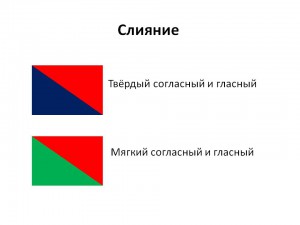
![]() Get started with simple words- one-syllable or two-syllable.
Get started with simple words- one-syllable or two-syllable.
So, you've made the cards and are ready for class.
Think about how to interest your child.
Maybe you can teach your doll Masha or your favorite bunny to form words?
Or will you solve riddles and make a diagram of the answer word?
Or maybe a word (card or picture) is hidden and you play the game “hot and cold”?
It’s very good if you come up with something interesting and have an incentive to work.
Fragment of the lesson.
Guess a riddle.
The grandfather is sitting dressed in a hundred fur coats.
Who undresses him?
He sheds tears.
Let's make a diagram of the word onion.
1. Divide the word into syllables.
We say bow with clap of our hands. This word has 1 syllable.
2. What sounds does a syllable consist of?
We pronounce it drawn out l-u-k.
The first sound is [l]. This is a hard consonant sound. The second sound is [u]. This is a vowel sound. The sounds [l], [u] merge together, resulting in a merger [lu]. We select the desired card - merging a hard consonant with a vowel sound.
The third sound [k] is a hard consonant. We choose a card for a hard consonant.
 3. Let's denote the sounds with letters. The sound [l] is denoted by the letter “el”. The sound [u] is the letter “u”. The sound [k] is the letter “ka”.
3. Let's denote the sounds with letters. The sound [l] is denoted by the letter “el”. The sound [u] is the letter “u”. The sound [k] is the letter “ka”.
We do not place stress on monosyllable words. The word has one vowel sound, which means it is stressed.
According to the “School of Russia” program, there are no designations for a voiced and a voiceless consonant. Therefore, you can show your imagination and come up with your own designations for a voiced and voiceless consonant. For example, in the game “Find out the sound” I chose a bell to represent a voiced consonant, and a smiley face with headphones on for a voiceless consonant. The pictures can be printed and used in the diagram.

You can practice characterizing sound in the game.
A game
A ribbon of letters will help you characterize the sound.

The tape shows very clearly what sounds the letters represent.
For example, the letter “en” denotes two sounds – hard [n] and soft [n’]. Therefore, the rectangle has two colors - blue and green. These sounds are ringing, so there is a bell on top.
All sounds in the top row are voiced, while those in the bottom row are voiceless.
The letter “zhe” denotes one sound – a hard sound [zh]. Therefore the rectangle is completely blue. This is a ringing sound.
Particular attention should be paid to iotated vowels.
The letters i, ё, yu, e can mean two sounds or one.
When they appear at the beginning of a word or after a vowel, they represent two sounds:
i [y’ a], yo [y’ o], yu [y’ y], e [y’ e]
After a consonant sound, they designate one sound: i [a], ё [o], yu [u], e [e].
Let's make a diagram of the word Yana.
1. Divide the word into syllables.
I'm on
This word has two syllables.
2. The first syllable is I. This is a fusion of two sounds – [th’], [a]. The sound [й’] is a soft consonant, the sound [a] is a vowel. We choose a card - a fusion of a soft consonant and vowel sound.
3. Place a dividing line after the first syllable.
3. The second syllable is na. This is a fusion of two sounds - [n], [a]. The sound [n] is a hard consonant, the sound [a] is a vowel. We choose a card - a fusion of a hard consonant and a vowel sound.
4. Put emphasis. We find the stressed syllable. We say the whole word, highlighting the stressed syllable. The stressed syllable is the first. So that the child understands that the stress is placed correctly, try placing the stress on the second syllable.

5. We designate sounds with letters.
The sounds [y'a] are denoted by one letter - the letter ya.
The sound [n] is denoted by the letter “en”.
The sound [a] is denoted by the letter a.
All symbols of sounds in the article are taken from the “School of Russia” program. But the most important thing for us is that the child learns to characterize sound and know how to work with models. If a child has learned to characterize a sound, then replacing the designation will not be difficult.
Drawing up sound patterns for words.
We can also call this type of work sound-letter word analysis or phonetic analysis .
Remember: sounds can be heard or spoken. A letter is a sign to indicate a sound. The letter can be written, read, seen.
Phonetics is a branch of the science of language in which the sounds of a language, stress, and syllables are studied.
We call the sounds that a person makes speech sounds. Speech sounds are formed in the speech apparatus when air is exhaled.
The speech apparatus is the larynx with vocal cords, oral and nasal cavities, tongue, lips, teeth, palate. When drawing up sound patterns for words, you must be able to divide sounds into vowels and consonants.
Vowel sounds consist only of the voice, exhaled air passes through the mouth freely, without encountering an obstacle. Vowel sounds can be drawn out for a long time and sung.Vowel sounds we will denote in red -
In russian language vowel sounds six: [a], [o], [y], [e], [s], [i]. Vowel sounds can be stressed or unstressed.
When we say consonants , the air meets an obstacle (lips, teeth, tongue). Some consonants consist only of noise - these are voiceless consonants. Others are made from voice and noise. These are voiced consonants.
Consonants are also divided into hard and soft.
Hard consonants indicated in blue -
soft- green-
Where to start?
Start working with simple words - one-syllable or two-syllable.Think about how to interest your child.
Maybe you can teach your doll Masha or your favorite bunny to form words?Or will you solve riddles and make a diagram of the answer word?
Or maybe a word (card or picture) is hidden and you play the game “hot and cold”?
It’s very good if you come up with something interesting and have an incentive to work.
Algorithm of work when compiling the sound diagram of a word
1.I pronounce the word.
2. I count the number of sounds and mark the sound windows.
3. I listen to the sound, analyze it: vowel or consonant; if the consonant is hard or soft.
4.I choose the desired color.
5. I count: how many sounds are there in a word, how many vowels, how many consonants - how many of them are hard consonants, how many are soft.
Fragment of the lesson.
Guess a riddle.
The grandfather is sitting dressed in a hundred fur coats.
Who undresses him?
He sheds tears.
Let's make a diagram of the word onion.
1. Divide the word into syllables.
We say bow with clap of our hands. This word has 1 syllable.
2. What sounds does a syllable consist of?
We pronounce it drawn out l-u-k.
The first sound is [l]. This is a hard consonant sound. Select the desired hard consonant card (blue color). The second sound is [y]. This is a vowel sound. Select the desired vowel sound card (red).The third sound [k] is a hard consonant. Select a card for a hard consonant (blue color).
3. Let's denote the sounds with letters. The sound [l] is denoted by the letter “el”. The sound [y] is the letter “u”. The sound [k] is the letter “ka”.
We do not place stress on monosyllable words.
TAPE OF LETTERS
To compile sound patterns of words, the following blanks are needed:
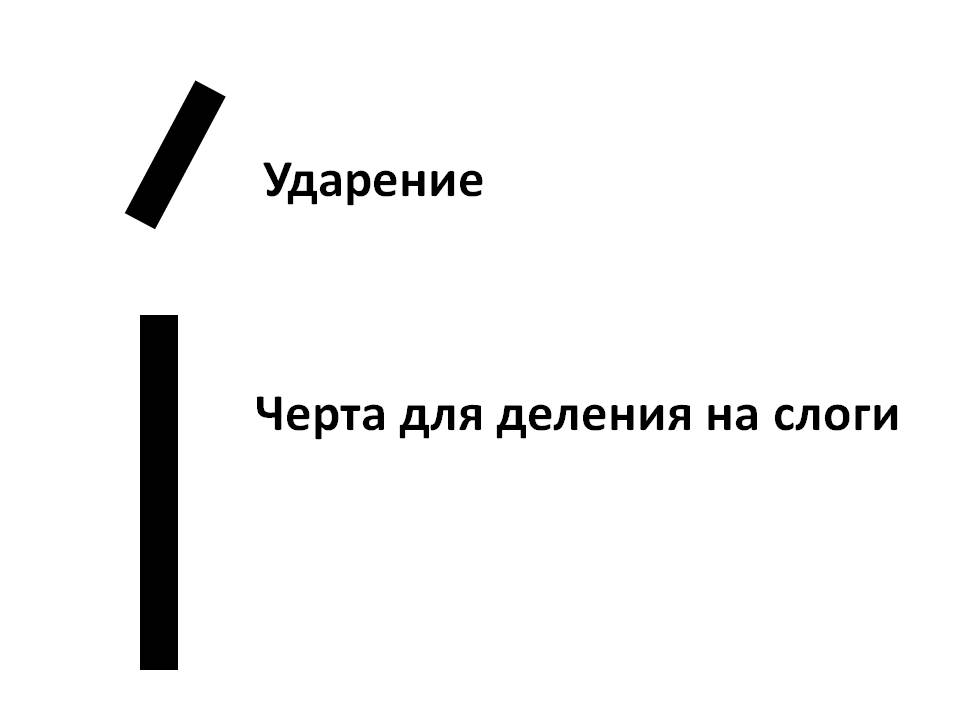
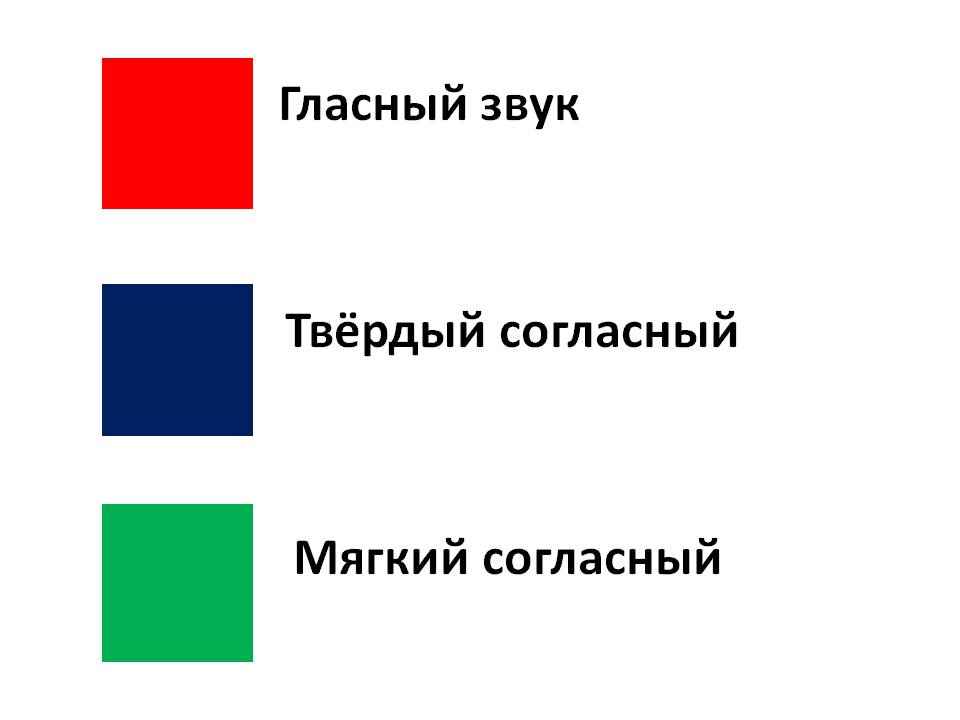
Even in early childhood, when a child is just learning to read, he is faced with the problem when words are pronounced differently from how they are written. For this reason, it is necessary to conduct a sound analysis with it. Why it is studied throughout the school curriculum will be discussed in our article.
Phonetics
Our speech is divided into two large types: oral and written. The first, naturally, appeared long before the second. After all, initially people learned to exchange information using gestures and simple sounds. Then this gradually grew into words that formed one language or another. But soon there was a need to record everything that was said. This is how it arose
In this article we will talk about the features of oral communication. This part of the language is studied by a complex science - phonetics. It deals with the sounds that make up our speech. Each of them has its own characteristics and individual characteristics. Their study is included in sound analysis.
Vowels
One of the most important parts of our spoken language is the presence of vowels. They are so named based on their main function - to transmit long-lasting sound with their voice. There are six of them in Russian: A, O, U, Y, I, E.
It must be remembered that the number of letters does not always coincide with the number of sounds. For example, the word “south” has 2 letters, but at the same time 3 sounds: “yuk”. A letter-sound analysis of a word should show what is different from the way we write.
Vowels make up syllables in words. It is by their number that they determine how many parts the word is divided into:
- stick- there are 2 syllables because it has two vowels;
- som - 1 syllable, since there is one vowel.
In addition, you need to know the features of letters such as e, ё, yu, ya. They, unlike all the others, can form two sounds - a vowel in combination with Y:
- Yo (y+o);
- E (y+e);
- Yu (y+y);
- I (y+a).
This phenomenon is observed in cases where the listed sounds are used:
- after soft or hard signs ( pours, zealous);
- after a vowel ( big, belt);
- at the beginning of a word ( Yula, El).
Very often, when performing a sound analysis of a word (the diagram is given below), children make mistakes precisely in parsing these vowels.

All the other characteristics that vowels have are quite simple. Especially those that are studied in the school curriculum. Only two signs are considered: stress or unstress.
Consonants
Before performing a sound analysis, you need to know the features and consonants. There are many more of them than vowels. The Russian language has thirty-seven of them.
Consonants have different characteristics:
- Softness or hardness. Some sounds can be pronounced without softening: sea (m- solid). Others are the opposite: measure (m- soft).
- Voiced or deaf. When a sound is pronounced with vibration and voice, it is called voiced. You can put your palm on your larynx and feel it. If vibration is not felt, then it is deaf.
- Pairing. Some consonants have their opposite. Usually in terms of sonority and deafness. For example: V(sound) - f(deaf) h(sound) - With(deaf).
- Some consonants are pronounced as if “in the nose”. They received the corresponding characteristic - nasal.
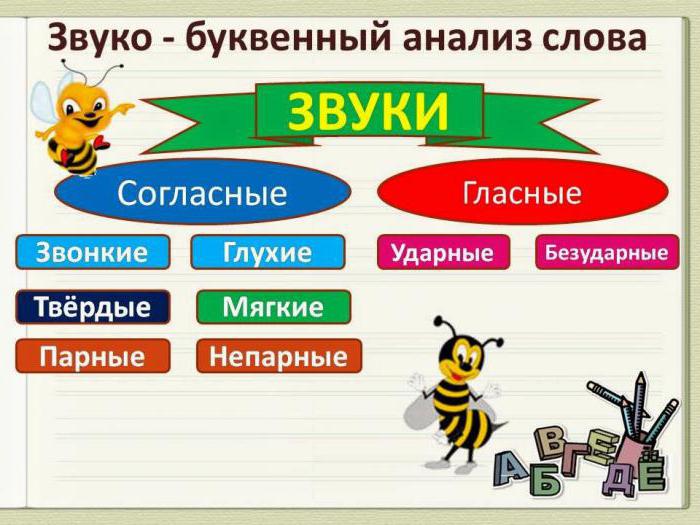
How to perform
Now you can create an algorithm that performs sound analysis of a word. The scheme is simple:
- First, we divide the word into syllables.
- Next, we write the letters that make it up in a column.
- Now for each we select the appropriate sound.
- We characterize each of them according to the characteristics described above.
- We count the number of sounds and letters.
- If their numbers do not match, we explain why this phenomenon occurred.
Let's give an example. Let's take the word "ceiling":
- This word has three syllables: ceiling(3 vowels, therefore the corresponding number of syllables).
- The letter P has a sound<П>. It is consonant, pronounced without vibration at the larynx, and therefore dull. It is also hard and has a couple<Б>.
- The letter O has a sound<А>. It is vowel and has no accent.
- The letter T has a sound<Т>. It is a consonant and is pronounced unvoiced. It is not softened and therefore hard. In addition, it has a pair of sonorities<Д>.
- The letter O has a sound<А>. It is vowel and unstressed.
- The letter L stands for sound<Л>. It is consonant, has no softening - hard. Pronounced with vibration at the larynx - sonorous. This sound has no pair.
- The letter O has a sound<О>. He is a vowel and, in in this case, percussion.
- The letter K stands for sound<К>. Consonant, pronounced like a voiceless consonant, has a voicing pair<Г>, solid.
- To summarize: this word has 7 letters and 7 sounds. The number is the same, no linguistic phenomena are observed.
Sound word analysis for preschoolers is much simplified.
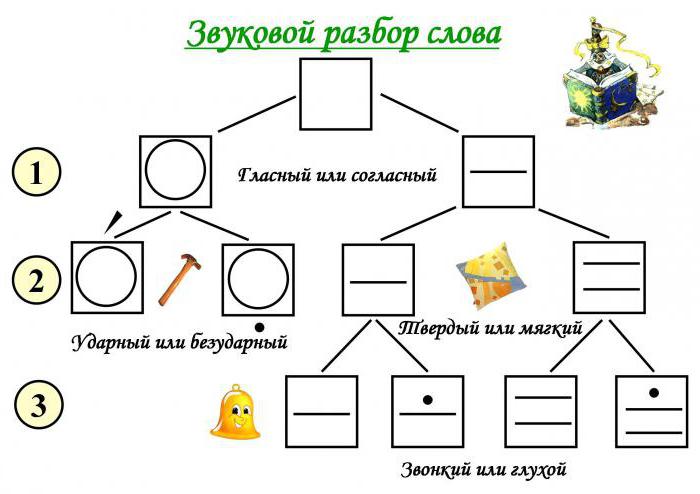
Children need to learn that the pronunciation of a word and its spelling are very often different. When learning reading and writing skills, children gain their first understanding of the difference between spoken and written language. Thus, it is enough for the teacher to explain that some letters, like soft and hard signs, have no sounds at all. But there are no words starting with the letter Y in the Russian language.
Letter-sound analysis of the word “blizzard”
We already know how diverse the Russian language is. The sound analysis in the previous example is quite simple. You just need to correctly characterize each sound. But there are those in which a problematic situation arises. For example, the word "blizzard". Let's execute it:
- Snowstorm- two vowels, which means 2 syllables ( snowstorm).
- The letter B has a sound<В’>. It is consonant, softened by “b”, paired - unvoiced<Ф’>, sonorous.
- The letter b has no sound. Its purpose is to demonstrate the softness of the previous sound.
- The letter Yu has two sounds<Й>And<У>, since it comes after b. Both need to be described. So,<Й>- this is a consonant that is always soft and voiced; it has no pair.<У>- vowel, has an accent.
- The letter G is a consonant and means solid sound. Has a deaf pair<К>and is voiced.
- Letter<А>has the same sound<А>. It is vowel and unstressed.
- Let's summarize the analysis: 5 letters and 5 sounds. We observe a phenomenon called “iotated vowel”. In this case, the letter Yu, under the influence of b, split into two sounds.
![]()
Conclusion
Sound analysis is not difficult to perform if you know all the characteristics. You need to say the word out loud. This will help you record all sounds correctly. Afterwards, characterize them and summarize phonetic analysis. And then success in this matter is guaranteed to you!



